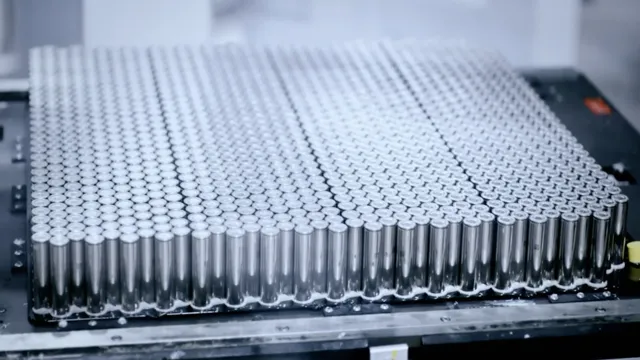Unraveling the Science of Charge Cycles on Electric Car Batteries: Maximizing Your EV’s Lifespan
Electric cars are quickly becoming the preferred mode of transportation for eco-conscious individuals. They are quiet, produce no harmful emissions, and can deliver impressive performance. However, the battery constitutes the most crucial component of an electric car.
It powers the vehicle and dictates the driving range. Therefore, users need to understand how electric car battery charge cycles work to ensure longevity and optimal performance. But, what exactly are electric car battery charge cycles? How do they impact the vehicle’s driving range and overall lifespan? These are the questions we’ll answer in this blog post.
So, buckle up and let’s dive in!
What are Charge Cycles?
Charge cycles on an electric car battery refer to the number of times the battery can be fully charged and discharged before it starts losing its ability to hold a charge. Essentially, one charge cycle occurs when your electric car battery goes from fully charged to fully discharged and back to fully charged again. Most electric car manufacturers indicate that their batteries can handle between 1000-2000 charge cycles, but this can vary based on the specific battery chemistry and how frequently the battery is discharged to its full capacity.
It’s important to note that charging habits, environmental conditions, and how the car is driven can all impact the overall lifespan of an electric car battery. In order to prolong the life of your battery, it’s recommended that you avoid frequent fast-charging, avoid fully discharging the battery whenever possible, and keep the battery within its optimal temperature range.
Understanding Battery Capacity
Battery capacity is an essential factor when it comes to choosing a device that has a rechargeable battery. Charge cycles are an important concept to understand as they determine the battery’s lifespan. A charge cycle refers to the process of discharging and recharging a battery from 100% to 0% and back again to 100%.
For instance, if you use your phone every day and it goes from 100% to 0% battery, then that would be considered one charge cycle. Most rechargeable batteries have a maximum number of charge cycles they can go through before they start losing their capacity and can no longer hold a charge. This is why it’s crucial to look at the charge cycle rating of the battery when you’re purchasing a device with rechargeable batteries.
Understanding charge cycles will help you extend the lifespan of your rechargeable batteries and get the most out of them.

Measuring Charge Cycles
Charge cycles are a term used to describe the number of times a rechargeable battery can go through a full charge and discharge cycle. Every time you use your device, the battery is depleted, and when you recharge it, that counts as one charge cycle. So, if you use your phone all day and recharge it overnight, that would be one charge cycle.
Understanding how charge cycles work is important as it can affect the longevity of your battery. As batteries age, their ability to hold a charge decreases, and after a certain number of charge cycles, the battery’s capacity will be significantly reduced, making it important to measure how many charge cycles the battery has gone through. This helps you to know when it’s time to replace the battery and avoid unexpected shutdowns or poor performance.
By keeping track of your device’s charge cycles, you can ensure your battery lasts as long as possible.
Factors Affecting Charge Cycles
Charge cycles on an electric car battery can be affected by a multitude of factors, which can either prolong or shorten the battery’s lifespan. One of the most significant of these factors is temperature. An excessive amount of heat can cause the battery cells to deteriorate quickly, while extreme cold can reduce the battery’s efficiency, which could result in a shorter lifespan.
Another factor that could affect charge cycles is the driving habits of the vehicle owner. Frequent rapid acceleration and heavy braking could cause a strain on the battery, leading to a faster depletion rate. Additionally, the battery’s health could deteriorate if it isn’t charged to a sufficient level or if it’s frequently charged to a full capacity, both of which could negatively affect the battery’s overall longevity.
Proper care and maintenance are essential to ensure that an electric car battery performs optimally and has an extended lifespan.
Temperature and Charging Speeds
Temperature and charging speeds are directly related to one another. As a battery gets colder, its charging speed decreases. This is because charging a cold battery risks damaging it due to the increased viscosity of the electrolyte.
Similarly, if a battery is too hot, it reduces the battery’s overall lifespan. The ideal temperature for charging is around 20 to 25 degrees Celsius, as it provides the optimal conditions for the battery to charge at its full capacity. Other factors that can affect the battery’s charging cycles include the age of the battery, the quality of the charger, and how the battery has been used in the past.
It’s crucial to be mindful of these factors to ensure that your battery lasts as long as possible and remains in good condition.
Depth of Discharge
Depth of discharge is a crucial factor affecting the charge cycles of your battery. If you fully discharge your battery, it takes more energy to charge it back up again, shortening the lifespan of the battery. This means that constantly fully discharging your battery can decrease the number of charge cycles it can go through before it needs to be replaced.
On the other hand, partially discharging your battery before recharging it can help to maximize its lifespan and the overall number of charge cycles. Keeping an eye on your depth of discharge can help you extend the life of your battery and save money in the long run. So, next time you’re using your battery-powered device, make sure to monitor its depth of discharge and recharge it when it gets low to keep it running smoothly.
Battery Chemistry
Battery Chemistry When it comes to battery chemistry, there are several factors that can impact the number of charge cycles a battery can go through before it needs to be replaced. One major factor is the type of battery chemistry being used. Different chemistries have different life expectancies and can handle different numbers of charge cycles.
Another important factor to consider is the temperature at which the battery is being operated. Batteries that are exposed to high temperatures have a shorter lifespan and can handle fewer charge cycles before they need to be replaced. Additionally, the depth of discharge (how much energy is drained from the battery) can also impact the number of charge cycles a battery can handle.
So, the more energy that is drawn from a battery during use, the fewer cycles it can withstand. By considering these factors and choosing the right battery for your needs, you can help ensure that your devices stay powered for as long as possible.
Maximizing Battery Life
When it comes to electric cars, one critical factor to keep in mind is maximizing the battery life. This means you need to be mindful of the charge cycles on your electric car battery. Every time you charge your car, it counts as a charge cycle, and these cycles contribute to the overall lifespan of your battery.
To maximize battery life, it’s best to avoid fully depleting the battery when you can. Instead, aim to keep the battery between 20%-80% charge as much as possible. Additionally, try to avoid keeping your car at full charge for long periods when it’s not in use.
These tips can help prolong the life of your battery and ensure that your electric car stays on the road for years to come.
Charge to 80%
Maximizing Battery Life One of the best ways to maximize your battery life is by charging your device up to 80% rather than letting it charge to 100%. This is because lithium-ion batteries, which are commonly used in smartphones and other electronic devices, have a limited number of charge cycles. Each time you charge your battery to 100%, it uses up one of these cycles.
By charging up to 80%, you can help extend the lifespan of your battery. It’s also important to avoid using your device while it’s charging, as this can cause it to overheat and damage the battery. Additionally, keeping your device at a moderate temperature and avoiding extreme heat or cold can also help prolong your battery’s life.
By taking these simple steps to maximize your battery life, you can ensure that your device stays powered up and ready to go whenever you need it.
Avoid Full Discharges
When it comes to extending the life of your battery, one important tip is to avoid full discharges. While it might be tempting to use your device until it completely dies, this can actually be harmful to your battery’s health. When a battery is completely drained, it puts extra strain on the cells and can reduce their overall capacity over time.
Instead, try to keep your battery between 20-80% charged, as this is the range where the battery operates at its best. If you do need to fully discharge your battery for any reason, make sure to charge it back up to at least 50% as soon as possible to prevent long-term damage. By following these guidelines, you can help maximize the lifespan of your battery and avoid the need for costly replacements.
Conclusion
After delving into the world of charge cycles on electric car batteries, we can conclude that these energy storage devices are not to be taken lightly. With a finite number of cycles available before degradation sets in, it’s crucial for electric car owners to be mindful of their charging habits and utilize technologies like regenerative braking to maximize the longevity of their batteries. So remember, charge cycles may seem like a mundane concept, but they can make all the difference in the lifespan of your electric car’s battery.
Stay attuned and charge on!”
FAQs
What is a charge cycle on an electric car battery?
A charge cycle is when an electric car battery goes from 100% charge to a lower percentage then back to 100% charge.
How many charge cycles can an electric car battery handle?
The number of charge cycles an electric car battery can handle varies depending on the manufacturer and model, but most batteries are designed to withstand at least 1,000 charge cycles.
What happens to an electric car battery after it completes its maximum number of charge cycles?
After an electric car battery completes its maximum number of charge cycles, it will have degraded to a point where it may no longer hold a sufficient charge to power the vehicle and will need to be replaced.
What can be done to extend the life of an electric car battery’s charge cycles?
To extend the life of an electric car battery’s charge cycles, it is important to avoid overcharging or fully discharging the battery, keep the battery within an optimal temperature range, and use a level 2 or higher charger whenever possible.






